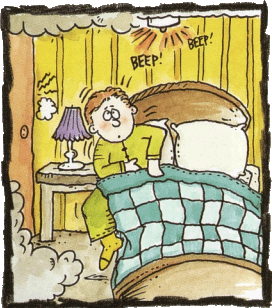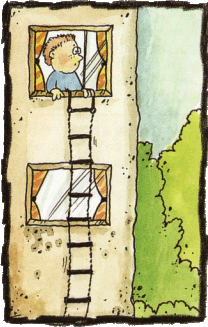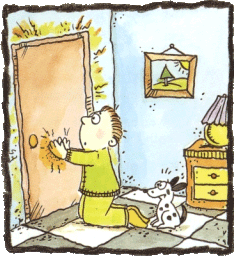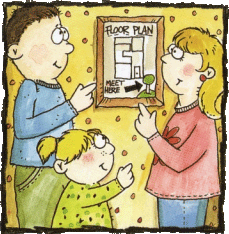Home Fire Escape Plan - Do I really Need One?
WHAT ARE THE REALITIES OF FIRE?
Fire can destroy anyone's home. Fires are real, not just events in the news or movies. Most people have no idea how destructive a fire can be. Here are some facts that everyone should know.
- Fire creates thick black smoke that makes it difficult to see.
- Smoke is more deadly than flames. The poisonous gases in the smoke can kill you. Many fire fatalities occur because people do not stay low and crawl under the smoke to a safe exit. Most fires occur at night while people are sleeping. Many people suffocate without ever waking and realizing the fire danger
- Fire has intense heat. A fire can create extreme temperatures in a matter of seconds. These temperatures can cause severe burns rendering you unconscious.
- Fire spreads rapidly. A home can be totally consumed in fire in less than five minutes. Working smoke alarms will provide an early warning of the problem, and a home fire escape plan will provide time to escape safely.
 |
| Smoke alarms save lives. |
During a fire there is no time to stop and think about an escape route - seconds are important! Knowing what to do before a fire occurs can save your life! Make an escape plan and practice it with your family today. The four simple steps to follow when making an escape plan are.
Step 1 Install working smoke alarms
Install a working smoke alarm on every level of your home and outside sleeping areas. For maximum protection install smoke alarms in every bedroom, especially if you sleep with your bedroom door closed. Test your smoke alarms monthly to ensure they are functioning properly.
Step 2 Draw a floor plan of your home

Make sure you have a safe way
to reach the ground.
Make an outline of each floor of your home and label each room. Identify at least two exits from each room. Windows can serve as the second emergency exit. If a window is considered an exit, make sure all family members can open the locks and windows easily for a quick escape. Security bars on windows and doors must have a quick-release mechanism to make escape possible.
Step 3 Choose a family meeting place
The meeting place should be a safe distance away from the house. All family members should be taught to report to the meeting place after escaping a fire. One person should go to a neighbour's house or the nearest phone in a safe location to contact 9-1-1 or their local emergency number. Know the emergency telephone number for your area.
Step 4 Schedule a home fire drill
- Practice getting out of the house through the various exits by holding fire drills. Practice your escape plan by having a fire drill at least twice each year.
WHAT SHOULD I DO IF THERE IS A FIRE?
- Get out quickly and safely. When the smoke alarm sounds, immediately start your escape. Do not try to gather possessions or pets.
- Check the door. Stay low behind the door, reach up and feel the door and the door handle for heat.
-
If the door feels cool, brace yourself against the door and open it slowly. If it is safe, leave the building and go directly to your meeting place. If you encounter smoke, crawl low under the smoke. Cleaner air is down low, near the floor. Once you are out of the building, stay out. There is nothing more important in your house than you and your family. Go to the meeting place to make sure everyone is safe. Phone 9-1-1 or your local emergency number from a neighbour's house.
Touch test the doors before opening. - If the door feels warm, or you see smoke or flames on the other side of the door, shut the door, and use your second escape route. If you must escape from an upper story window of a multi-level home, make sure you have a safe way to reach the ground, such as a fire escape ladder.
- If you are trapped, seal the openings around the door and vents with wet bedding or towels. Call 9-1-1 or your local emergency number and notify the fire department of your location. If it is safe to open a window and there is no smoke, open it to signal and yell for help.
IS THERE ANYTHING ELSE I NEED TO KNOW?
 |
| Plan and practice your fire escape drill. |
Older Adults
An older adult with restricted mobility should sleep on the ground floor. A special plan should be made to provide assistance to this person.
Children
Infants and many young children will also need assistance when escaping from the home. A special plan should be made to provide assistance to them. All children should be taught the steps to follow when escaping from the home. They should be involved with making and practicing the family home fire escape plan.
People with Physical Disabilities
Anyone with physical disabilities should have their bedroom on the ground floor. A special plan should be developed which provides assistance when escaping. If a family member has a hearing impairment, special smoke alarms are available.
Public Buildings
Look for exit signs. Knowing your escape routes is important - even when shopping, visiting the library, or inside any public buildings. If you hear a fire alarm in a public building, follow any instructions given over the public address system or from adults working in the building. In a hotel, take your room key with you as you may encounter smoke and need to re-enter your room for safety.
| Sponsored By: | ||||
 |
 |
 |
 Insurance InsuranceBrokers Association |
 |
| Greater Vancouver Fire Chiefs Association Public Education Committee | ||||
